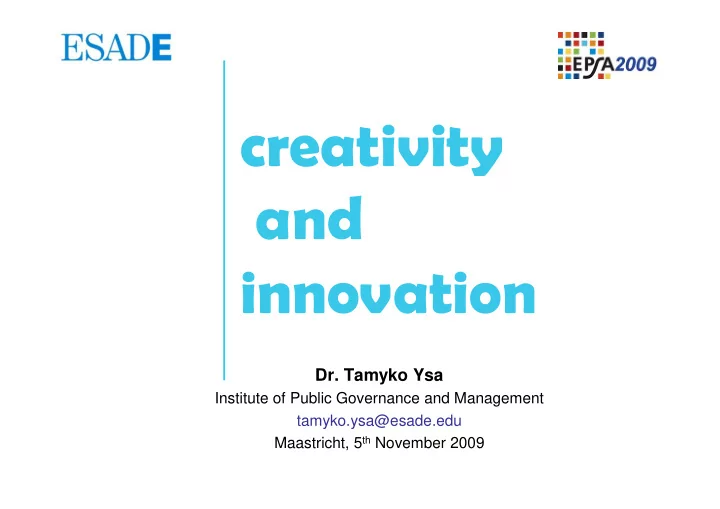

���������� ��� ���������� Dr. Tamyko Ysa Institute of Public Governance and Management tamyko.ysa@esade.edu Maastricht, 5 th November 2009
Two of the most profound innovations of the last 50 years came out of public organizations INTERNET Defense Advanced Research Projects Agency World Wide Web CERN
according to Wikipedia http://en.wikipedia.org/wiki/Innovation An innovation is a new way of doing something . It may refer to incremental and emergent or radical and revolutionary changes in thinking, products, processes, or organizations. http://en.wikipedia.org/wiki/Creativity Creativity is a mental and social process involving the generation of new ideas or concepts , or new associations of the creative mind between existing ideas or concepts http://en.wikipedia.org/wiki/Arete_(excellence) Arete (Greek), in its basic sense, means "goodness", "excellence" or "virtue" of any kind. In its earliest appearance in Greek, this notion of excellence was ultimately bound up with the notion of the fulfillment of purpose or function; the act of living up to one's full potential
PUBLIC SECTOR INNOVATION : Changes in the contents, structures or INNOVATION ways of operating within public administrations that work towards CREATIVITY creating public ENTREPRENEURSHIP value. � Ideas in part new (rather than improvements) � Taken up � Useful
Public administrations taking One doesn’t manage on the challenge of creativity. One manages innovation are forced to for creativity. take more risks than those which maintain patterns of behaviour guided by Amabile and Khaire, 2008 stability, precedents and Harvard Business School mere compliance of regulations. Longo, 2007 ESADE
Public innovation cannot be simply institutionalised or planned. But there are many things that governments can do to improve the chances of new ideas creating public value. NESTA 2007
1. Overcoming deeply ingrained norms • Public agencies approach innovation in terms of one-off change • No one’s job • Sustained innovation • Risk aversion matters • Too many rules • Do more with less • Uncertain results • High walls (silos) • Unsuitable structures (monopolistic)
Woody Allen “If you’re not failing every now and again, it’s a sign you’re not doing anything very innovative” RISKS in public management � Organizational � Political � Personal � New rules/ regulations
2. Drawing on the Rights Minds • Tap ideas from all Tap all sources of service innovation (employees, ranks private sector firms, – Seek new solutions nonprofits, other agencies, citizens) – Test new approaches Leadership and culture • Encourage and enable collaboration Policies, behaviours and • Open the organization symbols matter in rewarding innovation to diverse perspectives
Encourage and enable collaboration Benefit from cross-border diffusion
2006 2004 Innovation is more likely when people of different disciplines, backgrounds, and areas of expertise share their thinking
Brown University brain science program 2009 2008 � Mathematicians � Medical doctors � Neuroscientists � Computer scientists John Donoghue Director, Brain Science Program
Sir Peter Medawar The Nobel Prize in Medicine 1960 Predict ideas worth pursuing “To predict an idea is to have an idea” Because it is impossible to know in advance what the next big breakthrough will be
C reative = Abstrac t Innovative = Concrete Having ideas is seldom equal to getting things done Citizens Theodore Levitt 2007 Becoming involved in the changes required by social problems and demands
3. Bringing Process to Bear- Carefully • Map the phases of creative work • Provide paths through the bureaucracy Overcome internal constrains Rosabeth Moss Kanter • Create a filtering Harvard Business School mechanism “ Everything looks like a failure in the middle”
Innovation is about fail Fail fast PARTNER CULTIVATE Learn from the experience RISKS SELECTION SCAN NETWORK • Organizational • Political • Personal • New rules/ regulations OPEN SOURCE CONVERSION Prototypes Pilots DIFFUSION Only a small proportion of pilots deserve replication �������������������������
4. Fanning the Flames of Motivation • Provide intellectual challenge • Allow people to pursue their passions • Be an appreciate audience • Embrace the certainty of failure • Provide the setting for “good work”
Dr. Henry Sauermann College of Management at the Georgia Institute of Technology The keys to creativity output are indeed intellectual challenge and independence
Howard Gardner Mihaly William Damon Harvard Graduate Stanford Csikszentmihalyi School of Education Claremont Graduate University NOBLE work : work that is excellent technically, meaningful and engaging to the worker, and carried out in an ethical way
Where is the glory of being a “facilitator” as manager? The glory comes ELIZABETH LONG from helping LINGO others realize Vanderbilt University their unique SIOBHÁN O’MAHONY University of California talents and Davis reach a collective goal
Marrying Research to Practice
Higher education “InnoEnergy” how to design an integrative Research and Industry sustainable KIC* in the energy field? Challenge 1: Integrative Objectives Challenge 2: Partners commitment & Preparation Challenge 3: Governance Challenge 4: Managing the KIC *Knowledge and Innovation Community
1. Reasons for public sector How to innovate innovation • To become involved in the and serve the changes required by social public, not problems and demands 2. Purpose of innovation only by being • To maximize value created / competent in resource used the present, • To build up institutional capacities • To make public policies but also by sustainable. Respond to long-term being ready social needs 3. Necessary conditions for the future. • Relational governance • Incorporation of new values
Lack of theory of novelty . Three conditions necessary: SLACK OPTIMISM sufficient time and when a vision of + resources for exploration something truly different is made to seem more HUBRIS promising than the status inspiring managers to quo James take risks MARCH Stanford “Is possibly useful, even beautiful and just”
���������� ��� ���������� Dr. Tamyko Ysa Institute of Public Governance and Management tamyko.ysa@esade.edu Maastricht, 5 th November 2009
Recommend
More recommend